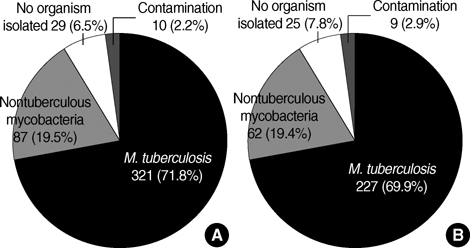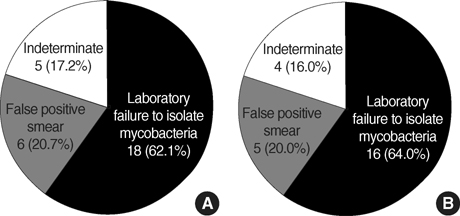J Korean Med Sci.
2008 Oct;23(5):767-771. 10.3346/jkms.2008.23.5.767.
The Incidence and Clinical Implication of Sputum with Positive Acid-Fast Bacilli Smear But Negative in Mycobacterial Culture in a Tertiary Referral Hospital in South Korea
- Affiliations
-
- 1Division of Pulmonary and Critical Care Medicine, Department of Internal Medicine and Lung Institute, Seoul National University College of Medicine, Seoul, Korea. yimjj@snu.ac.kr
- 2Department of Laboratory Medicine, Seoul National University College of Medicine, Seoul, Korea.
- KMID: 1783058
- DOI: http://doi.org/10.3346/jkms.2008.23.5.767
Abstract
- Although it is not rare to find sputum that is positive acid-fast bacilli (AFB) smear but subsequent culture fails to isolate mycobacteria in clinical practice, the incidence and clinical implication of those sputa from new patients has not been clearly elucidated. The aim of this study was to determine the incidence and clinical implication of sputum with positive AFB smear but negative in mycobacterial culture. All sputa that were positive AFB smear requested during diagnostic work up for new patients visiting Seoul National University Hospital from 1 January 2005 through 31 December 2006 were included. Sputa producing a positive AFB smear but negative mycobacterial culture were classified into one of four categories: laboratory failure to isolate mycobacteria, false positive AFB smear, pathogen may show a positive AFB smear other than mycobacteria, and indeterminate results. Out of 447 sputa with a positive AFB smear, 29 (6.5%) failed to culture any organism. Among these 29 sputa, 18 were caused by laboratory failure to isolate mycobacteria, six were false positive smears, and five indeterminate. Although most sputum with a positive AFB smear but negative culture could be classified as a laboratory failure, clinicians should consider the possibility of false positive AFB smear.
MeSH Terms
Figure
Reference
-
1. WHO. Global tuberculosis control. Surveillance, planning, financing. WHO Report 2007. 2007.2. Joh JS, Lee CH, Lee JE, Park YK, Bai GH, Kim EC, Han SK, Shim YS, Yim JJ. The interval between initiation of anti-tuberculosis treatment in patients with culture-positive pulmonary tuberculosis and receipt of drug-susceptibility test results. J Korean Med Sci. 2007. 22:26–29.
Article3. Warring FC Jr, Sutramongkole U. Nonculturable acid-fast forms in the sputum of patients with tuberculosis and chronic pulmonary disease. Am Rev Respir Dis. 1970. 102:714–724.4. Kothadia SN, Deshmukh S, Saoji AM. Evaluation of direct microscopy as a screening test in the diagnosis of pulmonary tuberculosis. Indian J Pathol Microbiol. 1990. 33:68–73.5. Rieder HL. Sputum smear conversion during directly observed treatment for tuberculosis. Tuber Lung Dis. 1996. 77:124–129.
Article6. Vidal R, Martin-Casabona N, Juan A, Falgueras T, Miravitlles M. Incidence and significance of acid-fast bacilli in sputum smears at the end of antituberculous treatment. Chest. 1996. 109:1562–1565.
Article7. Al-Moamary MS, Black W, Bessuille E, Elwood RK, Vedal S. The significance of the persistent presence of acid-fast bacilli in sputum smears in pulmonary tuberculosis. Chest. 1999. 116:726–731.
Article8. Kim TC, Blackman RS, Heatwole KM, Kim T, Rochester DF. Acid-fast bacilli in sputum smears of patients with pulmonary tuberculosis. Prevalence and significance of negative smears pretreatment and positive smears post-treatment. Am Rev Respir Dis. 1984. 129:264–268.9. Laboratory services in tuberculosis control, Part II: Microscopy. Geneva, Switzerland: 1998 World Health Organization.10. American Thoracic Society. Diagnostic standards and classification of tuberculosis in adults and children. Am J Respir Crit Care Med. 2000. 161:1376–1395.11. Bergmann JS, Yuoh G, Fish G, Woods GL. Clinical evaluation of the enhanced Gen-Probe Amplified Mycobacterium Tuberculosis Direct Test for rapid diagnosis of tuberculosis in prison inmates. J Clin Microbiol. 1999. 37:1419–1425.12. Gaude GS, Hemashettar BM, Bagga AS, Chatterji R. Clinical profile of pulmonary nocardiosis. Indian J Chest Dis Allied Sci. 1999. 41:153–157.13. Talamo TS, Norbut AM, Kessler GF Jr. Opportunistic pneumonia caused by a new acid-fast bacterium. Am J Clin Pathol. 1980. 74:842–845.
Article14. Kanaujia GV, Lam PK, Perry S, Brusasca PN, Catanzaro A, Gennaro ML. Integration of microscopy and serodiagnostic tests to screen for active tuberculosis. Int J Tuberc Lung Dis. 2005. 9:1120–1126.15. Frimpong EH, Adukpo R, Owusu-Darko K. Evaluation of two novel Ziehl-Neelsen methods for tuberculosis diagnosis. West Afr J Med. 2005. 24:316–320.
Article16. Laserson KF, Yen NT, Thornton CG, Mai VT, Jones W, An Do, Phuoc NH, Trinh NA, Nhung DT, Lien TX, Lan NT, Wells C, Binkin N, Cetron M, Maloney SA. Improved sensitivity of sputum smear microscopy after processing specimens with C18-carboxypropylbetaine to detect acid-fast bacilli: a study of United States-bound immigrants from Vietnam. J Clin Microbiol. 2005. 43:3460–3462.
Article17. Lipsky BA, Gates J, Tenover FC, Plorde JJ. Factors affecting the clinical value of microscopy for acid-fast bacilli. Rev Infect Dis. 1984. 6:214–222.
Article18. Ito K. Pseudo-recurrence of lung tuberculosis based on the detection of smear AFB positive sputum due to excretion of necrotic material. Kekkaku. 2004. 79:449–451.19. Daddi G, Lucchesi M, Zubiani M. Some remarks on the recent bacteriological research on tuberculosis. Indian J Chest Dis Allied Sci. 1982. 24:164–169.20. Salina EG, Vostroknutova GN, Shleeva MO, Kaprel'iants AS. Cell-cell interactions during formation and reactivation of "nonculturable" mycobacteria. Mikrobiologiia. 2006. 75:502–508.21. Biketov S, Mukamolova GV, Potapov V, Gilenkov E, Vostroknutova G, Kell DB, Young M, Kaprelyants AS. Culturability of Mycobacterium tuberculosis cells isolated from murine macrophages: a bacterial growth factor promotes recovery. FEMS Immunol Med Microbiol. 2000. 29:233–240.22. Shleeva M, Mukamolova GV, Young M, Williams HD, Kaprelyants AS. Formation of 'non-culturable' cells of Mycobacterium smegmatis in stationary phase in response to growth under suboptimal conditions and their Rpf-mediated resuscitation. Microbiology. 2004. 150:1687–1697.
Article23. Rogers BH, Donowitz GR, Walker GK, Harding SA, Sande MA. Opportunistic pneumonia: a clinicopathological study of five cases caused by an unidentified acid-fast bacterium. N Engl J Med. 1979. 301:959–961.24. Clavel A, Arnal AC, Sanchez EC, Cuesta J, Letona S, Amiguet JA, Castillo FJ, Varea M, Gomez-Lus R. Respiratory cryptosporidiosis: case series and review of the literature. Infection. 1996. 24:341–346.
Article25. Hilton E, Freedman RA, Cintron F, Isenberg HD, Singer C. Acid-fast bacilli in sputum: a case of Legionella micdadei pneumonia. J Clin Microbiol. 1986. 24:1102–1103.
Article26. Subhash HS, Christopher DJ, Roy A, Cherian AM. Pulmonary nocardiosis in human immunodeficiency virus infection: a tuberculosis mimic. J Postgrad Med. 2001. 47:30–32.
- Full Text Links
- Actions
-
Cited
- CITED
-
- Close
- Share
- Similar articles
-
- Comparison of Induced Sputum and Bronchoscopy in Diagnosis of Active Pulmonary Tuberculosis
- Comparison of Concentration Smear and Culture for Tubercle Bacilli
- Recovery Rate of Nontuberculous Mycobacteria from Acid-Fast-Bacilli Smear-Positive Sputum Specimens
- A clinical comparison of the urine acid-fast bacilli culture results in renal tuberculosis
- Increasing Trend of Isolation of Non-Tuberculous Mycobacteria in a Tertiary University Hospital in South Korea



